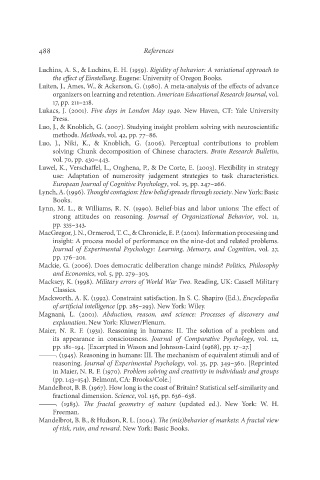Page 505 - Deep Learning
P. 505
488 References
Luchins, A. S., & Luchins, E. H. (1959). Rigidity of behavior: A variational approach to
the effect of Einstellung. Eugene: University of Oregon Books.
Luiten, J., Ames, W., & Ackerson, G. (1980). A meta-analysis of the effects of advance
organizers on learning and retention. American Educational Research Journal, vol.
17, pp. 211–218.
Lukacs, J. (2001). Five days in London May 1940. New Haven, CT: Yale University
Press.
Luo, J., & Knoblich, G. (2007). Studying insight problem solving with neuroscientific
methods. Methods, vol. 42, pp. 77–86.
Luo, J., Niki, K., & Knoblich, G. (2006). Perceptual contributions to problem
solving: Chunk decomposition of Chinese characters. Brain Research Bulletin,
vol. 70, pp. 430–443.
Luwel, K., Verschaffel, L., Onghena, P., & De Corte, E. (2003). Flexibility in strategy
use: Adaptation of numerosity judgement strategies to task characteristics.
European Journal of Cognitive Psychology, vol. 15, pp. 247–266.
Lynch, A. (1996). Thought contagion: How belief spreads through society. New York: Basic
Books.
Lynn, M. L., & Williams, R. N. (1990). Belief-bias and labor unions: The effect of
strong attitudes on reasoning. Journal of Organizational Behavior, vol. 11,
pp. 335–343.
MacGregor, J. N., Ormerod, T. C., & Chronicle, E. P. (2001). Information processing and
insight: A process model of performance on the nine-dot and related problems.
Journal of Experimental Psychology: Learning, Memory, and Cognition, vol. 27,
pp. 176–201.
Mackie, G. (2006). Does democratic deliberation change minds? Politics, Philosophy
and Economics, vol. 5, pp. 279–303.
Macksey, K. (1998). Military errors of World War Two. Reading, UK: Cassell Military
Classics.
Mackworth, A. K. (1992). Constraint satisfaction. In S. C. Shapiro (Ed.), Encyclopedia
of artificial intelligence (pp. 285–293). New York: Wiley.
Magnani, L. (2001). Abduction, reason, and science: Processes of discovery and
explanation. New York: Kluwer/Plenum.
Maier, N. R. F. (1931). Reasoning in humans: II. The solution of a problem and
its appearance in consciousness. Journal of Comparative Psychology, vol. 12,
pp. 181–194. [Excerpted in Wason and Johnson-Laird (1968), pp. 17–27.]
———. (1945). Reasoning in humans: III. The mechanism of equivalent stimuli and of
reasoning. Journal of Experimental Psychology, vol. 35, pp. 349–360. [Reprinted
in Maier, N. R. F. (1970). Problem solving and creativity in individuals and groups
(pp. 143–154). Belmont, CA: Brooks/Cole.]
Mandelbrot, B. B. (1967). How long is the coast of Britain? Statistical self-similarity and
fractional dimension. Science, vol. 156, pp. 636–638.
———. (1983). The fractal geometry of nature (updated ed.). New York: W. H.
Freeman.
Mandelbrot, B. B., & Hudson, R. L. (2004). The (mis)behavior of markets: A fractal view
of risk, ruin, and reward. New York: Basic Books.

